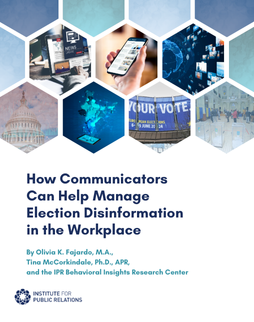Deconstructing is a new IPR blog series devoted to building a greater understanding of theoretical and practical terms and concepts that may be commonly used but not widely understood in the communication industry.
What is Psychological Safety?
In 1999, Dr. Amy Edmondson, a professor at Harvard Business School, published a seminal piece of research in Administrative Science Quarterly, exploring the concept of psychological safety in organizational teams. She defined team psychological safety as the “shared belief that the team is safe for interpersonal risk taking.” Central to the construct is an absence of fear and a sense of confidence within the team, founded on mutual respect and trust, and that the team will not “embarrass, reject, or punish someone for speaking up.” In a psychologically safe environment, colleagues feel obligated and are expected to be candid, fostering a free exchange of ideas. Being psychologically safe means one can be their full self and be fully present in the workplace.
The foundations of the theory are rooted in concepts developed by organizational theorists such as Edgar Schein and Irving Janis, the latter best known for his concept of groupthink (to be explored further in this IPR blog series). Since then, Dr. Edmondson’s work has inspired hundreds of articles and books on the positive impact of psychological safety on organizations. As more studies are published, more factors of the theory are identified.
What is Not Considered Psychological Safety?
In her 2018 book, “The Fearless Organization: Creating Psychological Safety in the Workplace,” Dr. Edmondson points out what is not psychological safety:
— Psychological Safety is not about being nice and polite or offering unconditional support
— Psychological Safety is not a personality factor and should not be equated with extroversion
— Psychological Safety is not interchangeable with trust
— Psychological Safety is not about lowering performance standards or not holding people accountable
— Psychologically safe teams do not fall under the spell that they are invincible
Why should we care?
A psychologically safe environment significantly improves happiness in the workplace. One Gallup study found that psychological safety improves retention, reduces safety incidents, and increases productivity. A meta-analysis (or an analysis of research analyses) found that psychological safety leads to stronger learning behavior, improved communication outcomes, better employee attitudes, and even employees engaging in more “work arounds,” or procedures to overcome roadblocks and enhancing workflow. Psychological safety is also strongly related to better firm performance, measured by return on assets and goal achievements. Psychological safety also positively affects perceptions of organizational support, access to mentoring, and diversity practices.
A psychologically safe environment can literally save lives. In the healthcare industry, research has found that hierarchical structures in hospitals can prevent employees, like nurses, from feeling comfortable enough to speak up about potential errors or problems when there is a lack of a psychologically safe work environment, leading to surgical errors, malpractice, or even death. But the importance of psychological safety is not just limited to healthcare as positive outcomes have been found across all industries. Google researchers—under the code-name Project Aristotle—wanted to find out what qualities make teams most effective. Many qualities can be found in exceptional teams, but the one that rose to the top was psychological safety.
Creating a psychologically safe work environment is easier said than done, but communicators can make a difference. The factors found in leaders who foster psychological safety include leader inclusiveness, support, trustworthiness, openness, and behavioral integrity. Psychological safety should be considered in everything we do in relation to our employees and teams. With the pandemic and continued uncertainty around the future of work and the hybrid workplaces, especially during this Great Resignation, psychological safety should be the top consideration for teams, especially as the lines between work and personal life blur.
Want to learn more about psychological safety? Check out these resources:
Duhigg, Charles. (Feb. 25, 2016). What Google learned from its quest to build the most perfect team. The New York Times. What Google Learned From Its Quest to Build the Perfect Team – The New York Times (nytimes.com)
Newman, Alexander; Donohue, Ross & Eva, Nathan. (2017). Psychological safety: A systematic review of the literature. Human Resource Management Review, 27(3), pp. 521-535. Psychological safety: A systematic review of the literature – ScienceDirect
Edmondson, Amy C. & Lei, Zhike. (2014). Psychological Safety: The History, Renaissance, and Future of an Interpersonal Construct. Annual Review of Organizational Psychology and Organizational Behavior. 1(1), 23-43. Psychological Safety: The History, Renaissance, and Future of an Interpersonal Construct (annualreviews.org)
Edmondson, A. C. (2018). The Fearless Organization: Creating Psychological Safety in the Workplace for Learning, Innovation, and Growth. The Fearless Organization: Creating Psychological Safety in the Workplace for Learning, Innovation, and Growth: Edmondson, Amy C.: 9781119477242: Amazon.com: Books





